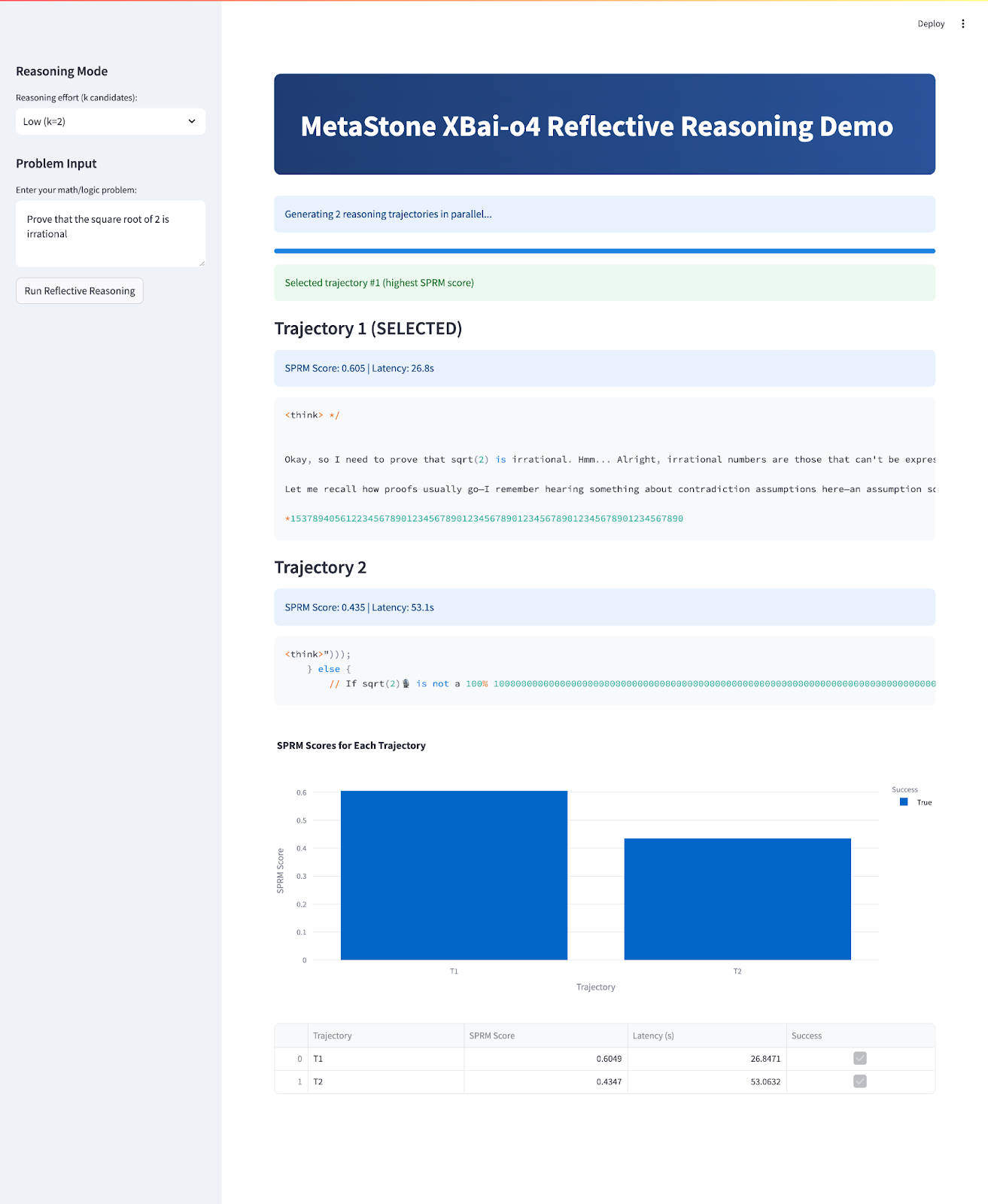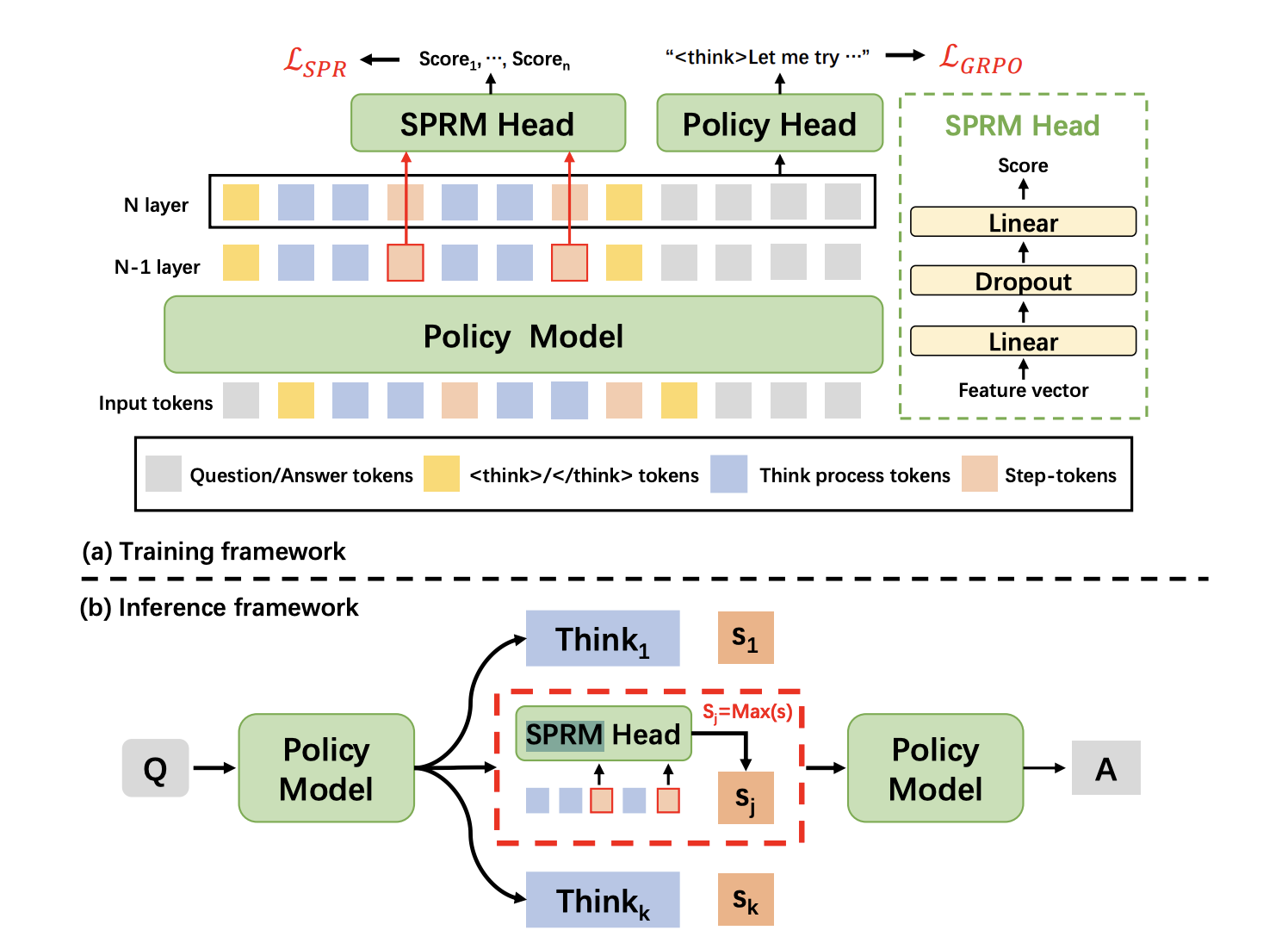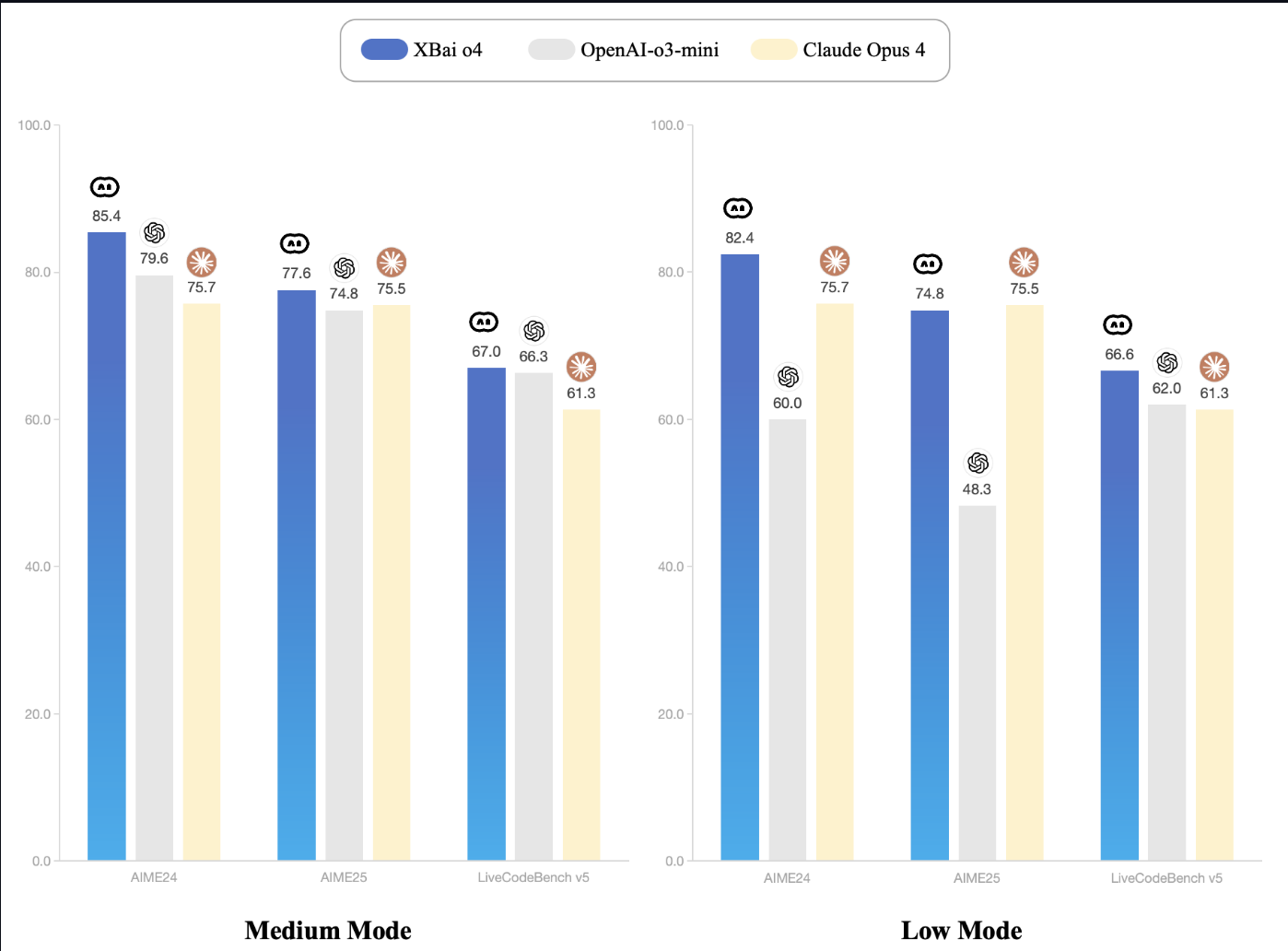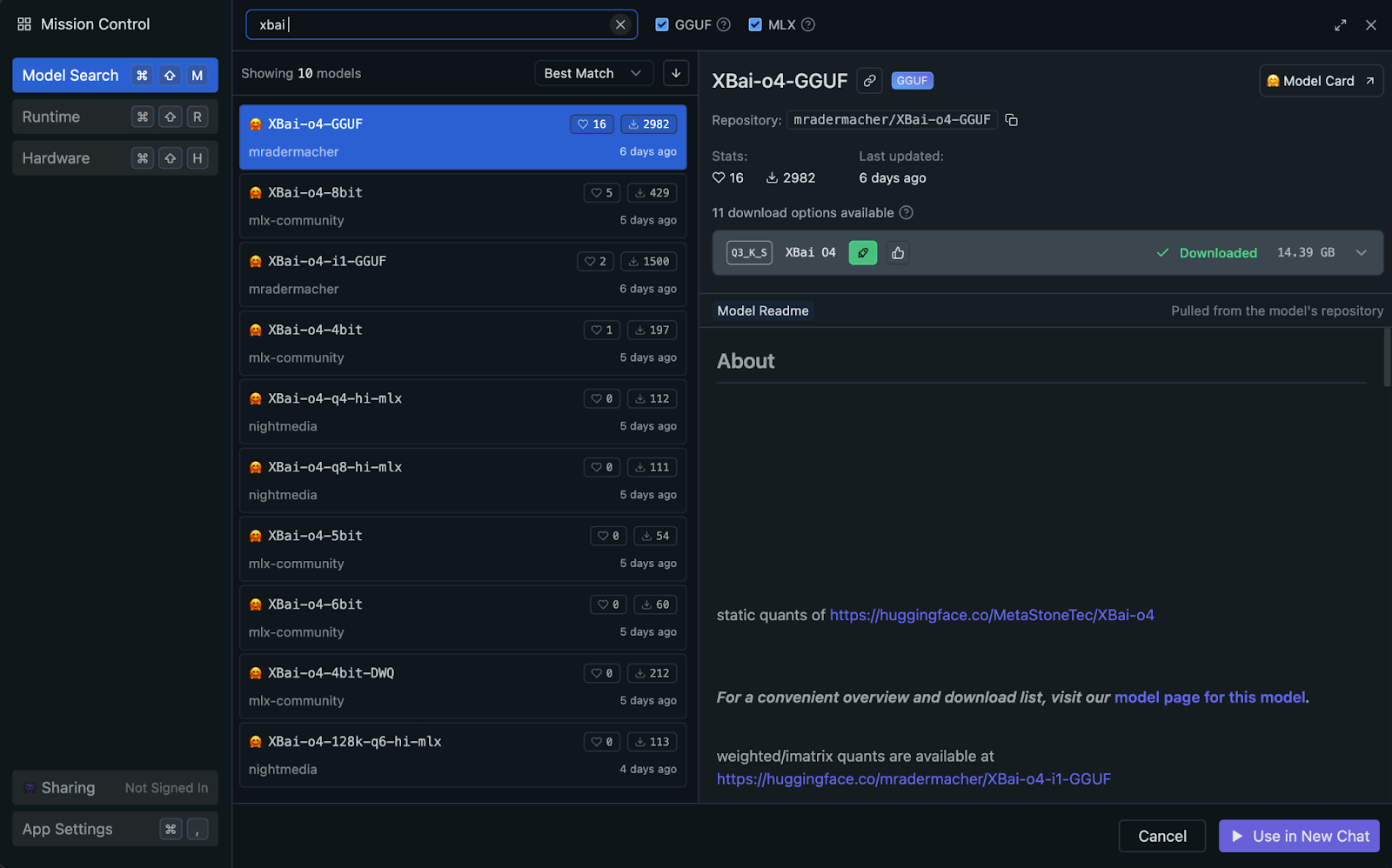Course
MetaStone AI recently released XBai-o4, an open-source reasoning model that introduces parallel test-time scaling and reflective generative architecture. With 32.8 billion parameters and an integrated self-evaluation head, XBai o4 outperforms OpenAI’s o3-mini (medium mode) across core mathematical reasoning benchmarks while running locally.
My focus in this blog will be on XBai o4's unique reflective reasoning capabilities, demonstrating how it generates and evaluates multiple solution trajectories for mathematical problems through a locally-deployed Streamlit interface powered by LM Studio.
In this tutorial, I'll explain step by step how to:
- Deploy XBai-o4 locally with LM Studio and GGUF quantization for optimal performance.
- Build a Streamlit app for real-time branch-by-branch reasoning visualization.
- Experiment with test-time scaling, dynamic temperature control, and reward-model scoring.
- Analyze and compare how different reasoning strategies and settings affect solution quality and efficiency.
At the end, your app will look like this:

What Is XBai-o4?
XBai-o4 is MetaStone AI’s fourth-generation open-source reasoning model, introducing a reflective generative architecture that tries to redefine how AI approaches complex problem-solving. Unlike traditional LLMs that treat answer generation and answer evaluation as two distinct processes, XBai o4 merges both into a unified model using a Shared Process Reward Model (SPRM). This design allows the model to generate, score, and select multiple reasoning paths in parallel.

Source: SPRM Head
At its core, XBai o4 combines long chain-of-thought (Long-CoT) reinforcement learning and process reward learning into a single training pipeline. Here are some key innovations introduced in this model:
- Reflective generative architecture: SPRM head shares the main model backbone, enabling both generation and self-evaluation in a single, highly efficient pass.
- Dynamic test-time scaling: The model instantly switches between 2, 8, or 32-branch reasoning modes, trading off speed and accuracy to fit your use case.
- Unified reasoning styles: This model excels at direct proofs, contradiction, induction, algebraic, and visual reasoning while handling a broad spectrum of math and logic problems.
- Performance leadership: On the AIME24 benchmark, XBai-o4 delivers great results. Even at its lowest setting, XBai o4 matches or surpasses OpenAI o3-mini, while using significantly less compute.

Source: XBai-O4 Documentation
How to Set Up XBai o4 Locally With LM Studio
You can run XBai o4 locally using LM Studio, which automatically uses your system’s GPU or Apple Silicon (Metal/MLX) acceleration when available (no manual setup required). For optimal performance and compatibility, I recommend using the GGUF quantized version of the model.
Why use the quantized GGUF version?
The GGUF (GPT-Generated Unified Format) standard enables highly efficient local inference by reducing the precision of model weights. In this project, we’ll use the Q3_K_S quantized variant, which is a popular choice for its excellent trade-off between quality and memory usage.
- Optimal balance: At just 14.39 GB, the
Q3_K_Sformat offers strong reasoning performance with minimal quality loss compared to full-precision models. - Broad compatibility: GGUF is the current standard for running quantized LLMs locally, working seamlessly on Mac, Windows, and Linux.
- Resource efficient: The 3-bit quantization makes it easy to run large models within a typical 32 GB RAM setup.
- Stable and fast: This model delivers reliable outputs and consistent inference speeds, even under parallel, multi-trajectory workloads.
Let’s walk through the step-by-step process of setting up the quantized GGUF model for efficient local inference using LM Studio.
Step 1: Install LM Studio
LM Studio offers GGUF support and automatically selects the optimal inference backend for your hardware, whether that’s Metal, GPU, or CPU.
If you haven’t installed LM Studio yet, simply download it from lmstudio.ai and follow the installation instructions.
Step 2: Download the XBai-o4 GGUF model
In LM Studio:
- Navigate to the Search tab
- Search for
mradermacher/XBai-o4-GGUF - Download the
XBai-o4.Q3_K_S.ggufvariant (14.39 GB).

Step 3: Load and Configure the Model
Once LM Studio is installed, we load and configure the XBai o4 model for local inference:
- Open LM Studio and navigate to the Local Server tab(top bar on your Mac).
- Select and load the
XBai-o4.Q3_K_S.ggufmodel from your downloaded models list. - Set the following configuration options:
- Context length: 8192
- Temperature: 0.7 (this will be dynamically adjusted in our demo)
- Max tokens: 1024
- GPU layers: Auto-detect (LM Studio will automatically optimize this based on your hardware capabilities)
- Start the local server, which by default runs on http://localhost:1234.
Once running, your system is ready for multi-trajectory reasoning with XBai o4.
Demo: Interactive XBai-o4 Reflective Reasoning
We'll now build a Streamlit application that demonstrates XBai o4's reflective reasoning capabilities with real-time performance comparison.
Step 1: Install dependencies
Start by installing dependencies:
pip install streamlit plotly pandas numpy requestsThis command ensures you have all the core dependencies for UI, data handling, plotting, and API requests.
Step 2: Import libraries and set up the page
Next, import all required libraries and configure your Streamlit page layout and basic settings.
import streamlit as st
import time
import requests
import numpy as np
import pandas as pd
import plotly.express as px
from typing import List, Dict, Any
LM_STUDIO_URL = "http://localhost:1234/v1" # change as per your server
REASONING_MODES = {"Low (k=2)": 2, "Medium (k=8)": 8, "High (k=32)": 8}
st.set_page_config(page_title="MetaStone-XBai-o4 Reflective Reasoning Demo", layout="wide")
st.markdown("""
<style>
.main-header {
background: linear-gradient(90deg, #1e3c72 0%, #2a5298 100%);
border-radius: 10px;
color: white;
text-align: center;
}
</style>
""", unsafe_allow_html=True)This code block imports all the core libraries required for our demo, including Streamlit for the web UI, as well as other basic libraries such as time, requests, numpy, pandas, plotly.express, and typing tools.
It then sets the model API endpoint LM_STUDIO_URL so the app knows where to send requests, and defines reasoning modes (REASONING_MODES) so users can easily select how many solution branches to generate.
Finally, we use st.set_page_config() to configure the Streamlit UI with a custom title, wide layout, and a CSS-styled gradient header.
Note: The LM_STUDIO_URL is the LLM server base URL, which you can copy from LM Studio. It’s usually - "http://localhost:1234/v1" but it can vary. Also, choose reasoning modes according to your server's capability.
Step 3: Helper functions
Now, let’s build out a set of helper functions that power the core “reflective reasoning” logic of our app. These functions make it easy to work with multiple trajectories, select the best solution, and score each answer.
Step 3.1: Checking model support for multi-trajectory sampling
This step introduces a simple helper function that automatically checks if our LM Studio server can handle multi-trajectory sampling. Some servers support the n parameter, which allows us to request several independent completions in one API call, thereby significantly speeding up the process.
def supports_n_param():
payload = {
"messages": [{"role": "user", "content": "What is 1+1?"}],
"max_tokens": 80,
"temperature": 0.1,
"n": 2,
"stream": False
}
try:
resp = requests.post(f"{LM_STUDIO_URL}/chat/completions", json=payload, timeout=120)
if resp.status_code == 200 and len(resp.json().get("choices", [])) == 2:
return True
except Exception:
pass
return FalseThis function checks whether your LM Studio server supports generating multiple answers (“trajectories”) in a single API call using the n parameter. It sends a quick test request and returns True if the feature is available, thus enabling true “Best-of-N” sampling for faster, more scalable reasoning.
Step 3.2: Generating trajectories
Once we've determined whether our backend supports multi-trajectory sampling, the next step is to generate multiple reasoning paths for a given problem. This section introduces a set of helper functions that either use server-side multi-sampling (when available) or efficiently parallelize single completions, ensuring the app remains fast and scalable.
def lm_studio_generate_multiple(problem, k, temperature=0.8, seed=2025):
prompt = f"<think> {problem}\n</think>"
payload = {
"messages": [{"role": "user", "content": prompt}],
"max_tokens": 196,
"temperature": temperature,
"top_p": 0.9,
"top_k": 30,
"n": k,
"stream": False,
"seed": seed
}
start = time.time()
resp = requests.post(f"{LM_STUDIO_URL}/chat/completions", json=payload, timeout=120)
latency = time.time() - start
if resp.status_code == 200:
result = resp.json()
return [{
"content": choice["message"]["content"].strip(),
"latency": latency / k,
"success": True,
} for choice in result.get("choices", [])]
else:
raise RuntimeError(f"LM Studio error: {resp.status_code}: {resp.text}")
def lm_studio_generate_single(problem, temperature, seed=None):
prompt = f"<think> {problem}\n</think>"
payload = {
"messages": [{"role": "user", "content": prompt}],
"max_tokens": 196,
"temperature": temperature,
"top_p": 0.9,
"top_k": 30,
"stream": False,
"seed": seed
}
start = time.time()
resp = requests.post(f"{LM_STUDIO_URL}/chat/completions", json=payload, timeout=120)
latency = time.time() - start
if resp.status_code == 200:
content = resp.json()["choices"][0]["message"]["content"].strip()
return {"content": content, "latency": latency, "success": True}
else:
return {"success": False, "error": f"HTTP {resp.status_code}: {resp.text}", "latency": latency}
def parallel_candidate_generation(problem, k, progress_cb=None):
import concurrent.futures
temperatures = np.linspace(0.1, 1.0, k)
results = []
with concurrent.futures.ThreadPoolExecutor(max_workers=min(8, k)) as executor:
futures = []
for i in range(k):
seed = 2025 + i * 31
futures.append(executor.submit(lm_studio_generate_single, problem, temperatures[i], seed))
for i, future in enumerate(concurrent.futures.as_completed(futures)):
res = future.result()
res["trajectory_id"] = i + 1
results.append(res)
if progress_cb:
progress_cb(i + 1, k)
results.sort(key=lambda x: x.get("trajectory_id", 0))
return resultsHere's how each function fits into the multi-trajectory pipeline:
lm_studio_generate_multiple()function: When the LM Studio server supports the n parameter, this function sends a single API request to generate k diverse solutions at once. This is the most efficient mode, enabling true test-time scaling.lm_studio_generate_single()function: If the server does not support multi-sampling, this function provides a fallback that generates one solution trajectory per request, allowing for different temperatures and reproducibility via seeds.parallel_candidate_generation()function: To keep performance in fallback mode, this utility fires off multiplelm_studio_generate_single()calls in parallel, each with different sampling temperatures, then aggregates all the responses. This ensures we still get a broad range of solutions quickly, even if true multi-sampling isn't available.
Step 3.3: Best trajectory
After generating multiple reasoning paths, we need a structured way to identify the strongest solution. This step introduces scoring and selection tools that mimic the reward modeling (SPRM) techniques used in the MetaStone Reflective Reasoning paper.
def step_tokenize(trajectory: str) -> List[str]:
steps = [step.strip() for step in trajectory.split('.\n\n') if step.strip()]
return steps
def dummy_sprm_score(trajectory: str, problem: str) -> float:
steps = step_tokenize(trajectory)
n = len(steps)
def step_score(step):
s = 0.2
if any(x in step.lower() for x in ["therefore", "thus", "so", "finally", "conclude"]): s += 0.15
if any(sym in step for sym in ["=", "+", "-", "*", "/", "(", ")"]): s += 0.1
if len(step.split()) > 10: s += 0.1
return min(1.0, s)
step_scores = [step_score(s) for s in steps] or [0.01]
geometric_mean = np.exp(np.mean(np.log(np.maximum(step_scores, 1e-3))))
return min(1.0, geometric_mean + 0.05 * np.log1p(n))
def best_of_n_selection(candidates: List[Dict]) -> int:
best_idx = int(np.argmax([c["sprm_score"] for c in candidates]))
return best_idxHere’s what each function does:
step_tokenize()function: This function splits a reasoning trajectory into logical steps or segments, allowing for step-wise analysis and scoring.dummy_sprm_score()function: This function assigns a reward score to each candidate trajectory and encourages responses that are multi-step, well-structured, and use mathematical reasoning. It acts as a stand-in for the paper’s Shared Process Reward Model (SPRM), which internally evaluates its solutions.- Note: This scoring function only approximates the original SPRM described in the original paper. The real SPRM is a learned reward model trained on large datasets to provide fine-grained, step-level feedback and requires substantial resources and proprietary data.
best_of_n_selection() function: Given a batch of candidate answers, this function selects the single best trajectory based on the highest SPRM score, just as the reflective model in the paper automatically picks its most robust answer at test time.
Step 4: Main Streamlit application flow
In this step, we bring together all the pieces to create an interactive reasoning demo with Streamlit.
st.markdown("""
<div class="main-header">
<h1> MetaStone XBai-o4 Reflective Reasoning Demo</h1>
</div>
""", unsafe_allow_html=True)
st.sidebar.header("Reasoning Mode")
mode = st.sidebar.selectbox("Reasoning effort (k candidates):", list(REASONING_MODES.keys()))
k = REASONING_MODES[mode]
st.sidebar.header("Problem Input")
problem = st.sidebar.text_area("Enter your math/logic problem:", "Prove that the square root of 2 is irrational")
if st.sidebar.button("Run Reflective Reasoning"):
st.session_state.run = True
st.session_state.results = None
st.session_state.best_idx = None
if "run" not in st.session_state:
st.session_state.run = False
if st.session_state.run:
st.info(f"Generating {k} reasoning trajectories in parallel...")
progress = st.progress(0)
def update_progress(done, total):
progress.progress(done / total)
try:
if supports_n_param():
results = lm_studio_generate_multiple(problem, k, temperature=0.7)
for idx, res in enumerate(results):
res["trajectory_id"] = idx + 1
else:
results = parallel_candidate_generation(problem, k, progress_cb=update_progress)
for res in results:
if res.get("success"):
res["sprm_score"] = dummy_sprm_score(res["content"], problem)
else:
res["sprm_score"] = 0.0
best_idx = best_of_n_selection(results)
st.session_state.results = results
st.session_state.best_idx = best_idx
st.session_state.run = False
except Exception as e:
st.error(f"Failed to generate trajectories: {str(e)}")
st.session_state.run = False
if st.session_state.get("results"):
results = st.session_state.results
best_idx = st.session_state.best_idx
st.success(f"Selected trajectory #{best_idx+1} (highest SPRM score)")
df = pd.DataFrame({
"Trajectory": [f"T{i+1}" for i in range(len(results))],
"SPRM Score": [r["sprm_score"] for r in results],
"Latency (s)": [r.get("latency", 0.0) for r in results],
"Success": [r.get("success", False) for r in results]
})
for i, res in enumerate(results):
is_best = (i == best_idx)
st.markdown(f"### {'' if is_best else ''} Trajectory {i+1} {'(SELECTED)' if is_best else ''}")
if res.get("success"):
st.info(f"SPRM Score: {res['sprm_score']:.3f} | Latency: {res['latency']:.1f}s")
st.code(res["content"])
else:
st.error(f"Failed: {res.get('error', 'Unknown error')}")
fig = px.bar(df, x="Trajectory", y="SPRM Score", color="Success", title="SPRM Scores for Each Trajectory")
st.plotly_chart(fig, use_container_width=True)
st.dataframe(df)The main application flow accomplishes several key goals:
- Sidebar configuration: The sidebar presents dynamic controls for setting the reasoning effort (i.e., number of sampled trajectories per query) and allows users to submit custom math or logic problems. Each mode (k=2, 8, 32) corresponds to a different test-time inference budget, enabling the user to analyze the scaling effects on solution quality.
- Execution trigger: The Run Reflective Reasoning button acts as a pipeline entry point, which triggers either efficient in-server multi-sample generation (n parameter), or parallel sampling via concurrent requests(if not supported by the backend).
- Progress tracking: As trajectories are generated, a progress bar provides real-time feedback, leveraging Streamlit’s stateful reactivity.
- Post-processing and scoring: Upon completion, each trajectory is evaluated using the proxy reward model (
dummy_sprm_score), which mimics the Shared Process Reward Model (SPRM). - Selection and display: The best trajectory is highlighted based on the reward score (
best_of_n_selection). All generated solutions, along with their respective SPRM scores and generation latencies, are rendered in both textual and graphical formats for side-by-side analysis.
To try it yourself, save the code as xbai_demo.py and launch:
streamlit run xbai_demo.pyConclusion
In this tutorial, we built an interactive multi-trajectory reasoning demo using MetaStone’s XBai o4 model. We explored:
- How XBai o4 introduces reflective generative reasoning by enabling the model to generate, score, and select multiple solution paths per problem
- The use of parallel test-time scaling to efficiently sample diverse reasoning trajectories
- Implementing a proxy reward model to score solution quality and automatically select the best answer
- Visualizing, comparing, and analyzing multiple trajectories in a single Streamlit interface

I am a Google Developers Expert in ML(Gen AI), a Kaggle 3x Expert, and a Women Techmakers Ambassador with 3+ years of experience in tech. I co-founded a health-tech startup in 2020 and am pursuing a master's in computer science at Georgia Tech, specializing in machine learning.

